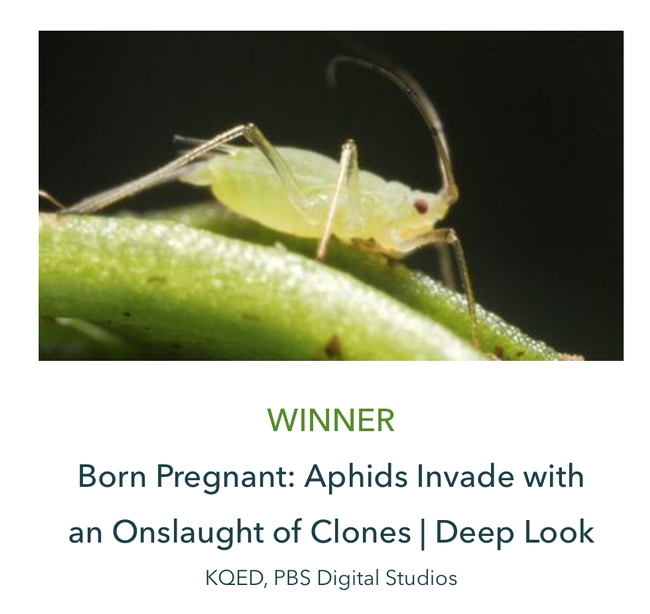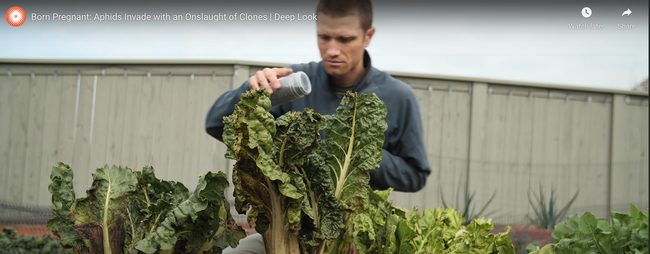
UC Cooperative Extension specialist and agricultural entomologist Ian Grettenberger of the UC Davis Department of Entomology and Nematology faculty, assisted with the KQED Deep Look video, "Born Pregnant: Aphids Invade with an Onslaught of Clones," that won a nature award equivalent to an Oscar.
Grettenberger provided his expertise--and some aphids--working with digital video producer Josh Cassidy, senior video producer for KQED Science and the lead producer and cinematographer for Deep Look, a short-form nature series that illuminates fascinating stories in the natural world.
Cassidy's aphid video scored an international Jackson Wild Media Award, winning first place in the category, "Animal Behavior, Short Form video (17 minutes or less)."
In selecting it as the best film in its category, the judges related that it "most effectively explores animal behavior in an innovative and illuminating way."

The aphid video came about when Cassidy approached Grettenberger looking for researchers working on aphids. "I told him I wasn't working in the lab with aphids, but he could come check out my garden, which happened to be chock full of them," Grettenberger related.
"It was almost all shot at my house/garden," Grettenberger said. "With COVID being a thing, Josh got to sit in my garage and shoot aphid videos. I helped some to form the story, and the final shots of the developing larvae/parasitoid were some I took since Josh couldn't sit around waiting for the parasitoid larvae to develop." Grettenberger is pictured in one of the frames.
The video reveals that "female aphids are the matriarchs of a successful family operation--taking over your garden. But don't lose hope; these pests have some serious predators and creepy parasites looking to take them down."
Comments posted on YouTube include:
- "You guys are just nailing it with this production and sound effects. Amazing!!"
- "BRILLIANTLY DONE!! Makes you want to "love" aphids !!!"
- "One more amazing video from this amazing channel! You guys rock!"
- "Deep Look is a phenomenal YouTube channel. The videos are so beautiful. I can't believe how their team keeps making epic after epic biologically significant videos."
Cassidy, who holds a bachelor's degree in wildlife biology from Ohio University and pursued research on marine mammals, studied science and natural history filmmaking at San Francisco State University and Montana State University. A long-time member of the Deep Look team, he is known for his excellent work in creating innovative and fascinating videos. See some of his science videos here.
Grettenberger, who joined the UC Davis Department of Entomology and Nematology faculty in January, 2019, focuses his research on field and vegetable crops; integrated pest management; applied insect ecology, and biological control of pests. He holds a bachelor's degree in biology from Western Washington University and a doctorate in entomology from Pennsylvania State University.
Grettenberger administers a YouTube channel on Pests and Natural Enemies. One of his most popular videos is his post on Lady Beetle Larvae and a Baby Aphid--Scoop, Scoop, Chomp Chomp: "A lady beetle larvae (Coccinella septempunctata--seven-spotted lady beetle) making short work of this baby aphid. You can see how they can eat *many* per day and help regulate aphid populations. (Predation part slowed down to 50%. They chow down more quickly). This is pea aphid, which can be a pest of alfalfa and other legume crops."
From KQED website: "KQED, a National Public Radio (NPR) and Public Broadcasting Service (PBS) affiliate in San Francisco, serves Northern California and beyond with a public-supported alternative to commercial TV, radio and web media. Funding for Deep Look is provided in part by PBS Digital Studios. Deep Look is a project of KQED Science, the largest science and environment reporting unit in California. KQED Science is supported by The National Science Foundation, the Dirk and Charlene Kabcenell Foundation, the Vadasz Family Foundation, the Gordon and Betty Moore Foundation, Campaign 21 and the members of KQED."
Attached Images:
